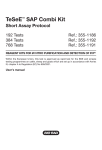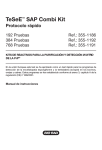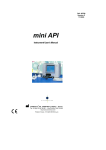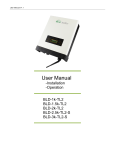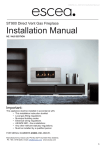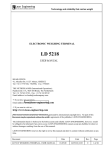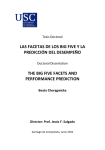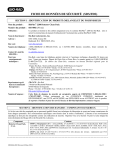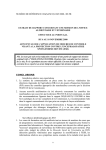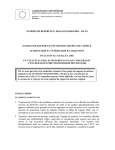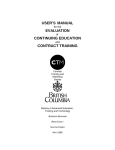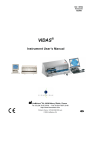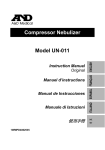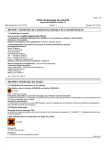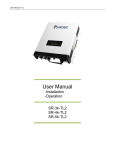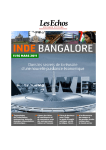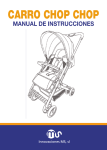Download BioRad TeSeE™ (768 tests English) - TSE-LAB-NET
Transcript
PURIFICATION KIT (768 tests) TeSeE™ DETECTION KIT (768 tests) - Short Assay Protocol Ref.: 355-1181 Ref.: 355-1182 REAGENT KITS FOR IN VITRO PURIFICATION AND DETECTION OF PrPSc Within the European Union, this test is approved as rapid test for the BSE and scrapie testing programmes on cattle, sheep and goats which are set up in accordance with Annex III, chapter A to Regulation (EC) No 999/2001. User’s manual User’s manual TABLE OF CONTENTS 1 - GENERAL INFORMATION 2 - TeSeE™ PURIFICATION KIT 2-1 Principle of purification of PrPSc 2-2 Samples 2-3 Composition of the TeSeE™ Purification Kit 2-4 Preparation of reagents 2-5 Storage, shelf-life 2-6 Procedure 2-7 Limits of the purification protocol 3 - TeSeE™ SAP DETECTION KIT 3-1 Principle of PrPSc detection by EIA 3-2 Samples 3-3 Composition of the TeSeE™ SAP Detection Kit 3-4 Preparation of reagents 3-5 Storage, shelf-life 3-6 Preparation of samples for PrPSc detection by EIA 3-7 Procedure 3-8 Calculation and interpretation of the results 3-9 Limits of the test 4 - MATERIAL REQUIRED BUT NOT SUPPLIED 5 - PRECAUTIONS 6 - HYGIENE AND SAFETY INSTRUCTIONS 7 - REFERENCES 2 1 - GENERAL INFORMATION Transmissible Spongiform Encephalopathies (TSE’s) are slow degenerative diseases of the central nervous system induced by unconventional transmissible agents (UTAs) routinely called prions. TSEs are generally classified according to their etiology, as iatrogenic, familial and/or sporadic. Sheep scrapie has been reported in the 18th century and transmission demonstrated (including to goats). However, the modes of contamination within flocks remain obscure. TSEs were also described in deer and elk (chronic wasting disease, CWD) and in cow (Bovine Spongiform Encephalopathy, BSE). Humans are also susceptible to certain forms of TSE. There is compelling evidence supporting that Bovine Spongiform Encephalopathy (BSE) has passed from cattle to human, probably through consumption of contaminated meat. In addition to this variant form of Creutzfeldt-Jakob disease (vCJD), other forms in humans include the Kuru and the iatrogenic Creutzfeldt-Jakob disease. Pure hereditary forms (such as the Gerstmann-Sträussler-Scheinker syndrome [GSS]) and/or sporadic CJD have been demonstrated in humans, but their incidences are low. We do not know if similar sporadic TSE cases exist in animals. The main characteristics of these diseases are: • a slowly progressive but always fatal course, • absence of conventional infectious agents, • progressive accumulation in the central nervous system of an abnormal isoform of the natural prion protein (PrP) called PrPSc. This isoform is characterized by particular biochemical properties and especially by an increased resistance to proteases. The strikingly long incubation period that precedes the neurological symptoms suggests that important events of TSE pathogeneses might take place in extra nervous sites and especially in peripheral lymphoid tissues. In spite of many unknown and/or incertitudes, the detection of abnormal PrP Sc is now established as the method, to confirm TSE diagnosis. This detection is mainly achieved from post mortal collected nervous tissues. Abnormal PrPSc has also been detected in a number of lymphoid tissue and organs: in the germinal centres of spleen, lymph nodes, tonsils, and/or mucosa-associated lymphoid tissue (but at the research area), in animal models or in scrapie sheeps, CWD deers and elks and vCJD patients. Reagent designed by the “Commissariat à l’Énergie Atomique - CEA” (French Atomic Energy Commission), developed, produced and marketed by Bio-Rad, allow PrPSc detection on samples of nervous tissues taken from animals. 3 This determination comprises the following reaction steps: • Purification of PrPSc (768 tests) Step performed with the following reagents and accessories: Ref.: 355-1181 - TeSeE™ Purification Kit (768 tests) - Calibration syringe and needle (x 200) Ref.: 355-1174 or Filter plates (x 50) Ref.: 355-1179 - Deepwell microplates (x 50) Ref.: 359-0132 - Medium beads (x 2000) Ref.: 355-1171 • PrPSc detection (768 tests) Step performed with the following reagents: - TeSeE™ Detection Kit (768 tests) - Short Assay Protocol 4 Ref.: 355-1182 TeSeE™ PURIFICATION KIT 768 TESTS 355-1181 REAGENT KIT FOR IN VITRO PURIFICATION OF PrPSc User’s manual 5 2-1 PRINCIPLE OF PURIFICATION OF PrPSc The reagents of the TeSeE™ Purification Kit allow purification, concentration and solubilisation of PrPSc from samples of tissues obtained from infected animals. Processing of the samples comprises the following steps: • Grinding of samples • Treatment of samples with Proteinase K • Concentration of PrPSc by precipitation • Solubilisation of PrPSc for immunoenzymatic assay using the reagents of the TeSeE™ SAP Detection Kit (Ref.: 355-1182). 2-2 SAMPLES Bovine: purification of PrPSc is performed on samples from Central Nervous System (CNS). The BSE extraction tool (Ref.: 355-1130) can be used to collect brainstem. Since distribution of PrPSc is heterogeneous in central nervous system, obex area from brainstem must be preferably sampled for optimal detection. Sampling syringe (Ref.: 355-1175) allows easy and rapid sampling of obex area in a secure way. Please refer to sampling protocol for detailed instructions on good sampling procedure. Small ruminants and cervids: purification of PrPSc is performed on samples from Central Nervous System (CNS) or peripheral tissues (lymphoïd nodes, spleen,…). The small ruminant extraction tool (Ref.: 355-1184) can be used to collect both brainstem and cerebellum. Since distribution of PrPSc is heterogeneous in central nervous system, obex area from brainstem must be preferably sampled for optimal detection. Samples are cut and weighed individually. Note: other tissues (tonsils, ileum, eyelid…) can be used for research purposes only. Samples are stored at +2°C to +8°C when purification is performed within 24 hours or can be stored frozen for several months. They can only be submitted to 3 freezing/thawing cycles. If these samples must be transported, they should be packaged in accordance with current local regulations. 2-3 COMPOSITION OF THE TeSeE™ PURIFICATION KIT LABELLING TYPE OF REAGENTS PRESENTATION STORAGE Grinding Tube Grinding tube containing ceramic beads in a buffer solution Preservative: ProClin™ 300 (0.1%) 8 bags (8 x 96 tubes) +2°C to +25°C Reagent A Denaturing solution Reagent B Reagent C PK Clarifying solution Colouring: bromophenol blue Resolving buffer Colouring: malachite green Proteinase K Colouring: phenol red 4 vials (55 ml) 4 vials (55 ml) 4 vials (7 ml) 4 vials (0.5 ml) +2°C to +8°C +2°C to +8°C +2°C to +8°C +2°C to +8°C Reagent A, reagent B and grinding tubes are generic components. They can be used with all batches of the TeSeE™ Purification Kits. 6 2-4 PREPARATION OF REAGENTS All reagents of the TeSeE™ Purification Kit except proteinase K are ready for use. Reagent A is the dilution buffer for proteinase K. The solution must be prepared in the following way (4 μl of proteinase K in 1 ml of reagent A): NUMBER OF SAMPLES REAGENT A PROTEINASE K 2 1 ml 4 μl 10 3 ml 12 μl 18 5 ml 20 μl 26 7 ml 28 μl 34 9 ml 36 μl 42 11 ml 44 μl 50 13 ml 52 μl 58 15 ml 60 μl 66 17 ml 68 μl 74 19 ml 76 μl 82 21 ml 84 μl 90 23 ml 92 μl The volumes must be pipetted exactly. The tip containing the PK has to be correctly rinsed by successive aspiration/distribution cycles in reagent A. After reconstitution, homogenize the solution by successive inversions until you obtain a red homogeneous solution. 2-5 STORAGE, SHELF-LIFE Store the TeSeE™ Purification Kit (Ref.: 355-1181) at +2°C to +8°C. All reagents are stable at this temperature until the expiry date indicated on the kit (before and after opening of the vials). After dilution, the reconstituted proteinase K solution when stored at room temperature (+18°C to +30°C) must be used within 6 hours. 2-6 PROCEDURE For the semi-automatic processing of the purification protocol, please refer to the TeSeE™ NSP operator’s manual. Procedure for manual processing: 1. Sampling: For peripheral tissues (lymph nodes, spleen,…) insert one medium bead (Ref.: 355-1171) in the grinding tube, before to add the sample. Take a mass of 350 mg ± 40 mg of nervous tissue (preferably in the obex area) or 200 mg ± 20 mg of peripheral tissue. Deposit the samples in grinding tubes, close firmly and proceed to the grinding step in the homogenizer (Ribolyser®, TeSeE™ PRECESS 24™ or TeSeE™ PRECESS 48™ systems). 7 2. Sample grinding: Place the tubes in the crown of the homogenizer (Ribolyser®, TeSeE™ PRECESS 24™ or TeSeE™ PRECESS 48™ systems). Perform one agitation cycle with the following instrument parameters: Ribolyser® TeSeE™ PRECESS 24™ or 48™ Nervous tissues Peripheral tissues Nervous tissues Peripheral tissues Time (sec.) 45 2 x 45* - - Speed 6.5 6.5 - - - - Program 1 Program 2 Program * Wait a 5 minutes pause between the 2 agitation cycles. When grinding is insufficient, another 1 or 2 agitation cycles can be performed, by ensuring that the temperature of the tube returns to room temperature (+18°C to +30°C) between each cycle (using crushed ice for example). 3. Sample transfer: Remove the grinding tubes from the homogenizer, resuspend the homogenate by inversion before opening the tubes. Transfer the homogenate with one of the following methods: • Calibration syringe method Take 250 μl with the calibration syringe (Ref.: 355-1174) taking care to immerse the needle in the pellet of beads to avoid sampling poorly homogenized tissue fragments. Transfer each 250 μl sample into a 2 ml Eppendorf micro test-tube or Deepwell (Ref.: 359-0132). • Filter plate method The transfer and the filtration are done separately using a filter plate (Ref.: 355-1179) and a Deepwell plate (Ref.: 359-0132), with either one of the two following filtration techniques. - Vacuum technique: Fit the Deepwell plate (Ref.: 359-0132) (the master plate) in the bottom of the vacuum manifold, place the lead of the manifold and then the filter plate (Ref.: 355-1179). Take at least 400 μl (≤ 1000 μl) with a 1000 μl tip and transfer in one well of the filter plate (Ref.: 3551179), exclude the first 6 positions (from A1 to F1). Place a plastic sealing film on top the filter plate. Set the vacuum gauge of the pump (Ref.: 359-0350) to 25.4 cm Hg (± 2.5%). Switch the pump on and check the gauge for correct vacuum, then open manifold valve for 1 minute ± 6 seconds. Close the valve, switch off the pump and release the vacuum from the manifold. - Centrifugation technique: Take at least 400 μl (≤ 1000 μl) with a 1000 μl tip and transfer in one well of the filter plate (Ref.: 355-1179) priorly fitted on a Deepwell plate (Ref.: 359-0132) (the master plate ), exclude the first 6 positions (from A1 to F1). Place a plastic sealing film on top the filter plate. Centrifuge the complete system (filter plate and Deepwell plate) for 1 min at 500 g. Taking care to keep the filtration plate securely in position on the Deepwell plate. Note: Centrifuge must be equipped with Deepwell microplate rotor (Ref.: 359-0136), for 5804R Eppendorf centrifuge (Ref.: 359-1396). After either technique discard the filter plate and transfer 250 μl of filtered samples into another Deepwell (the purification plate) for the manual protocol or directly place the master plate on board the NSP (refer to the TeSeE™ NSP operator’s manual). 8 Note: At this stage, grinding tubes after homogenisation, micro test-tubes and Deepwell plate after sample transfer can be stored, closed: At room temperature (+18°C to +30°C) for 8 hours At +2°C to 8°C (in ice or refrigerator) for 15 hours At -20°C for 1 year* Grinding tubes and micro test-tubes Yes Yes Yes Deepwell plate Yes Yes No * Frozen samples must be thawed at room temperature (+18°C to +30°C). Samples can be submitted to a maximum of 3 freezing/thawing cycles. Samples must always be homogenized by inversion before use. 4. PK treatment: Distribute 250 μl (± 10%) of reconstituted proteinase K solution [see paragraph 2.4] into each micro-tube or Purification plate well. Do not exceed intervals of 5 minutes for distribution of reconstituted proteinase K between the first and the last sample. Immediately homogenise closed tubes or Deepwell sealed with aluminium film 10 times by inversion. Do not exceed 2 minutes between the homogenization and the incubation at 37°C. Incubate at 37°C ± 2°C in a heating block incubator for 10 ± 1 minute. Note: If using Deepwell, heating block must be equipped with a Deepwell rack adaptor for heating block (Ref.: 359-0134). 5. Precipitation of PrPSc with reagent B: Remove the micro test-tubes or Deepwell plate from the heating block incubator. Open the tubes and distribute 250 μl (± 10%) of reagent B into all micro test-tubes or Deepwell wells. Observe the same order of distribution as described in step 4. Do not exceed intervals of 2 minutes between the exit of the incubator and the homogenization. Homogenization is performed under the same conditions as in step 4. 6. Concentration of the PrPSc (centrifugation): Within 30 minutes, after reagent B distribution and mixing : centrifuge the micro test tubes or purification plate as follows: Centrifugation Micro test-tubes Deepwell plate Speed (g) 20 000 15 000 2 000 Time (mm) 5 7 10 20 20 4 Temperature (°C) Note: For Deepwell plate allow a 5 minute delay at 37°C or a 10 minute delay at room temperature (+18°C to +30°C) before centrifugation. 7. Sample clarifying: Discard the supernatant by inverting the micro test-tubes over a waste container. Dry the micro test-tubes by inverting onto absorbent paper for 5 minutes. Or load the Deepwell plate on DW40 unit (Ref.: 359-0137). Select “TSE DW” program and select number of strips to be performed. Deepwell plate wells must be dried at the end of the DW40 process, by inverting the plate on absorbent paper for 5 minutes. 9 Distribute 25 μl (± 10%) of reagent C into all micro test-tubes or Deepwell wells. Do not exceed an interval of 10 minutes between the end of the drying operation and distribution of buffer C. Incubate immediately for 5 ± 1 minute at 100°C ± 5°C. Do not exceed 2 minutes between the reagent C distribution and the beginning of the incubation. Do not seal the Deepwell plate during incubation. Note: If using Deepwell, heating block must be equipped with a Deepwell rack adaptor for heating block (Ref.: 359-0134). Remove the micro test-tubes or the Deepwell from the incubator, and homogenate the tubes with a vortex (5 ± 2 seconds). Samples in micro test-tubes or Deepwell can be stored for 5 hours at +2°C to +8°C or frozen for 72 hours at -20°C. Frozen samples must be thawed at room temperature (+18°C to +30°C) and homogenized with a vortex (5 ± 2 seconds). Please refer to information on TeSeE™ SAP Detection package insert (Ref.: 355-1182) for detailed detection assay protocol. 2-7 LIMITS OF THE PURIFICATION PROTOCOL Difficulties can be encountered during the grinding step when using dehydrated samples or peripheral tissues. If necessary, the grinding step (step No.2 of the procedure) may need to be repeated several times for this type of sample. 10 TeSeE™ DETECTION KIT - Short Assay Protocol 355-1182 768 TESTS REAGENTS FOR IN VITRO DETECTION OF PrP AFTER PURIFICATION Sc User’s manual 11 3-1 PRINCIPLE OF PrPSc DETECTION BY EIA The TeSeE™ SAP Detection Kit is an immuno-enzymatic technique (sandwich format) using 2 monoclonal antibodies for the detection of the abnormal prion protein, resistant to proteinase K, in tissues collected from infected animals. The kit contains sufficient reagents to assay 768 tests (including controls). The solid phase is composed of 12 strips of 8 polystyrene wells coated with the first monoclonal antibody. The second monoclonal antibody is bound to peroxidase. The assay comprises the following reactive steps: 1. Distribution of negative (R3) and positive controls (R4), samples prepared with the reagents of the TeSeE™ Purification Kit (Ref.: 355-1181) in the wells of the microplate coated with the first monoclonal antibody. This distribution can be visually controlled, as there is a marked colour difference between an empty well and a well containing a sample. 2. Incubation. 3. Washing, then distribution of the peroxidase-labelled antibody. This distribution can also be visually controlled by the colour difference between an empty well and a well containing the conjugate solution. 4. Incubation. 5. Washing, then revelation of enzymatic activity bound to the solid phase by addition of the substrate. 6. Stopping of the colour development, determination of optical density at 450 nm - 620 nm (bichromatism mode) and interpretation of the results. 3-2 SAMPLES The assay can only be performed on samples obtained from collected tissues treated with the reagents and under the conditions of use of the TeSeE™ Purification Kit (Ref.: 355-1181). Purified samples must be diluted with reagent R6 of the TeSeE™ SAP Detection Kit. 12 3-3 COMPOSITION OF THE KIT LABELLING R1 R2 R3 R4 R6 R7 TYPE OF REAGENT Microplate: 12 strips of 8 wells coated with an anti-PrP monoclonal antibody Wash solution: 10-fold concentrated Tris-NaCl buffer pH 7.4. Preservative: ProClin™ 300 (0.01%) Negative Control: PBS buffer pH 7.2 supplemented with BSA Preservative: ProClin™ 300 (0.1%) Positive Control: PBS buffer pH 7.4 supplemented with non infectious synthetic peptide. Lyophilized. Preservative: ProClin™ 300 (0.1%) Sample diluent: PBS buffer pH 7.2 supplemented with BSA and phenol red Preservative: ProClin™ 300 (0.1%) Conjugate: 10-fold concentrated peroxidase-labelled anti-PrP monoclonal antibody in PBS buffer pH 7.1 solution supplemented with bovine proteins and coloured with phenol red Preservative: ProClin™ 300 (0.1%) PRESENTATION 8 plates 4 vials (250 ml) 4 vials (4 ml) 4 vials 4 vials (35 ml) 4 vials (2.8 ml) R8 Peroxidase Substrate Buffer: Solution of citric acid and sodium acetate pH 4.0 containing 0.015% H2O2 and 4% dimethylsulfoxide (DMSO) 4 vials (60 ml) R9 Chromogen: Tetramethylbenzidine (TMB) solution. 4 vials (5 ml) R10 Stop solution: 1 N sulphuric acid. Adhesive films 4 vials (28 ml) 16 The following reagents are generic components: sample diluent (R6), wash solution (R2), peroxidase substrate buffer (R8), chromogen (R9) and stop solution (R10). They can be used with all batches of the TeSeE™ SAP Detection Kits. 3-4 PREPARATION OF REAGENTS Before use, let the reagents of the TeSeE™ SAP Detection Kit adjust to room temperature (+18°C to +30°C) for 30 minutes. 1- Ready to use reagents Microplates (R1): Before opening the sealed bag with a desiccant, let the microplate adjust to room temperature (+18°C to +30°C) in its protective packaging to avoid any water condensation in the wells. Open at the solder point and immediately return the unused rows to the sachet. Tightly close the bag after expelling any air, then store at +2°C to +8°C. The negative control (R3), sample dilution solution (R6) and stop solution (R10) are ready to use. 13 2- Reagents to reconstitute Wash solution (R2): Dilute wash solution R2 to 1/10 in distilled or ultrapure water (example 100 ml of reagent R2 in 900 ml of distilled water). Positive control (R4): Gently tap the vial of positive control (R4) on the laboratory bench to detach any substance adherent to the rubber stopper. Open the vial and dissolve the content in 4 ml of diluent R6. Reseal the vial and let stand for approximately 1 minute, homogenizing gently and occasionally to facilitate dissolution. Conjugate (R7): Dilute reagent R7 to 1/10 in the freshly reconstituted wash solution (example: 0.1 ml of reagent R7 in 0.9 ml of reconstituted wash solution) bearing in mind that 1 ml of ready-for-use conjugate is sufficient for 1 row. Homogenize gently. Avoid using a vortex agitator. Enzymatic development solution (R8 + R9): Dilute reagent R9 to 1/11 in reagent R8 (example: 0.1 ml of reagent R9 in 1 ml of reagent R8) bearing in mind that 1.1 ml of enzymatic revelation solution is sufficient for 1 row. Homogenize gently. Avoid using a vortex agitator. 3-5 STORAGE, SHELF-LIFE Store the kit at +2°C to +8°C before use; all reagents are stable at this temperature until the expiry date indicated on the kit. The shelf-lives of the reagents after preparation are as follows: LABELLING REAGENT R1 Microplate in tightly closed sachet 1 month at +2°C to +8°C SHELF-LIFE R2 Diluted wash solution 24 hours at room temperature (+18°C to + 30°C) 2 weeks at +2°C to +8°C R4 Reconstituted positive control 2 hours at room temperature (+18°C to + 30°C) 4 hours at +2°C to +8°C 6 months at -20°C It is recommended to divide the reconstituted solution into 0.5 ml aliquots and to store them immediately at -20°C. Can be submitted to 3 successive freezing/thawing cycles. R7 Reconstituted conjugate solution (with diluted wash solution) 8 hours at room temperature (+18°C to + 30°C) R8 + R9 Development solution 6 hours at room temperature (+18°C to + 30°C) always protected from light 3-6 PREPARATION OF SAMPLES FOR PrPSc DETECTION BY EIA Purified samples (chapter 2.6) must be diluted with 125 μl (± 10%) of reagent R6. Diluted samples must be homogenized with vortex (5 sec. ± 2 sec.) just before distribution into the plate (R1). 14 3-7 PROCEDURE TeSeE™ Detection Kit - Short assay Protocol (Ref.: 355-1182) Procedure Procedure for manual processing: 1. Remove the microplate rack and the required number of rows (R1) from the protective packaging. Replace the unused rows with the desiccated bag in the microplate sachet and hermetically close it. 2. Prepare the positive control (R4), as described in chapter 3.4.2. 3. For each series of tests and every single plate, distribute 100 μl (± 10%) of control/sample into wells in the following order: - Wells A1, B1, C1, D1: negative control (R3) - Wells E1, F1: positive control (R4) - Wells G1, H1, etc… : sample diluted with reagent (R6) Samples are performed in singulate. 4. Cover with adhesive film and incubate for 30 mn ± 2 mn at 37°C ± 2°C. 5. Prepare wash solution (R2). 6. Prepare conjugate solution (R7). 7. Remove the adhesive film, perform 3 wash cycles. Optimal washing conditions are obtained with PW40, PW41 or 1575 Bio-Rad plate washers with program TSE 3. Do not let the microplate stand for more than 5 minutes after the last wash cycle. Dry by inversion on absorbent paper before the following step. 8. Distribute 100 μl (± 10%) of conjugate solution (R7) into each well. 9. Cover with adhesive film and incubate 30 mn ± 2 mn at +2°C to +8°C. 10. Prepare the enzymatic revelation solution (R8+R9). 11. Remove the adhesive film, perform 5 wash cycles. Optimal washing conditions are obtained with PW40, PW41 or 1575 Bio-Rad plate washers with program TSE 5. Do not let the microplate stand for more than 5 minutes after the last wash cycle. Dry by inversion on absorbent paper before the following step. 12. Distribute 100 μl (± 10%) of revelation solution (R8+R9) into each well and incubate the plate in darkness and at room temperature (+18°C to +30°C) for 30 mn ± 2 mn. Do not use adhesive film during this incubation. 13. Add 100 μl (± 10%) of stop solution (R10) to each well according to the same sequence and same distribution rate as for the revelation solution. 14. Thoroughly wipe the bottom of the plate and determine the optical density at 450 nm - 620 nm (bichromatism mode) within 30 minutes after stopping the reaction (the rows must always be protected from light before reading). 15 16 - Method 2 STRIPS Manifold - - STRIPS - - - Method 2 - - - - Plate - Plate - Yes Yes - MODE CROS SW ASP. BOTTOM ASP. Plate WASH - Met. (Method) Yes Yes - MODE CROS SW ASP. BOTTOM ASP. Plate WASH - Met. (Method) Flat BOT: SHAPE 1,4 ASP. HOR. POS. 0,3 CENTERING 13,5 ASP. VERT. POS. 9,5 BOT. VERT. POS. PLATE NAME: FLAT 01 (PW40/PW41) - FLAT 03 (1575) - Flat 01 (PW40/PW41) 1*8 (PW40/1575) 1,2,3,4, Flat 03 (1575) 2*8 (PW41) 5,6,7,8,9, 10,11,12 Method 1 Main parameter PLATE NAME: TSE 5 - EDIT mode function Manifold Flat 01 (PW40/PW41) 1*8 (PW40/1575) 1,2,3,4, Flat 03 (1575) 2*8 (PW41) 5,6,7,8,9, 10,11,12 PLATE Method 1 Main parameter EDIT mode function NAME: TSE 3 Microplate washer parameters 9,5 - 2,5 - - W1 - - - 2,5 - 6 - - W1 HORIZONTAL SPEED 800 - 8 - - - - 1 - - - - - - - - 6 9 DISP. UPW. SPEED - - - 1 - - 6 BOT. DOWNW. SPEED - - - BOT. BOTTOM BOT. SHAKE WASH TIME ASP. TIME NUMBER NUMBER - - - BOT. BOTTOM BOT. SHAKE WASH TIME ASP. TIME NUMBER NUMBER ASP. DOWNW. SPEED 0 (PW40/1575) 5 (PW41) - FLOW - 0 (PW40/1575) 5 (PW41) - FLOW VERTICAL SPEED VOLUME OVER LIQUID FLOW - 800 - VOLUME OVER LIQUID FLOW B.W. VERT. POS. 0,3 0,3 - ASP. TIME 0,3 0,3 - ASP. TIME 9 - SOAKING 0 30 (PW41) 45 (PW40/1575) - SOAKING 1 SHAKING AMPLITUDE 0 30 (PW41) 45 (PW40/1575) BOT. UPWARD SPEED 1 5 - Nr OF CYCLES 1 3 - Nr OF CYCLES - 0 - MET. INTER - 0 - MET. INTER - - - 9 SHAKING SPEED - - 1 - - - Nr OF KIT KITS INTER - - 1 Nr OF KIT KITS INTER 3-8 CALCULATION AND INTERPRETATION OF THE RESULTS 1) Calculation of the mean optical density (OD) of the negative control OD R3 = mean of the four OD of R3 wells 2) Calculation of the cut-off value The cut-off value is equal to : OD R3 + 0.210 Example OD R3 = 0.020 Cut-off value = 0.020 + 0.210 = 0.230 3) Condition of validation of the test • Negative control (R3): a) Validation of the individual negative control values: The optical density of each individual negative control must be lower than 0.150. However, a maximum of one individual aberrant value can be eliminated when its optical density is higher or equal to 0.150. The test must be repeated if more than one of the negative control lies outside of this limit. b) Homogeneity of the negative control values: Calculate the mean of the negative controls with the individual remaining values. Values higher than the mean of the negative controls + 40% (OD R3 + 40%) must be eliminated. - If one individual value is eliminated in a), one additional value can be eliminated in b). - If no negative control value is eliminated in a), two values maximum can be eliminated in b). The test must be repeated if more than two values of the negative control are eliminated [criteria a)+b)]. • Positive control (R4): The mean of the positive control optical densities (R4 ODs) must be higher or equal than 1.000. The test must be repeated if the mean of the positive control optical densities (R4 ODs) is strictly lower than this limit. 4) Interpretation of the results Samples with an optical density lower than the cut-off value are considered to be negative according to the TeSeE™ SAP Detection Kit. However, results situated just below the cut-off value (cut-off value - 10%) must be interpreted cautiously, and the corresponding samples should be retested in duplicate, starting from the original homogenate. Samples with an optical density greater than or equal to the cut-off value are considered to be initially reactive according to the TeSeE™ SAP Detection Kit and should be retested in duplicate, starting from the original homogenate, before the final interpretation. After repeating the test, the sample is considered to be positive according to the TeSeE™ SAP Detection Kit when at least one of the 2 measurements is positive (greater than or equal to the cutoff value). The sample is considered to be negative according to the TeSeE™ SAP Detection Kit when these two values are less than the cut-off value. Samples retested in duplicate and found to be negative according to the TeSeE™ SAP Detection Kit, but for which one of the 2 values is close to the cut-off value (cut-off value 10%) must be interpreted cautiously. 17 3-9 LIMITS OF THE TEST A negative result means that the test sample does not contain any PrPSc detectable by the TeSeE™ SAP Detection Kit. However, as very low levels of PrPSc may not be detected, such a negative result does not exclude the possibility of infection. Any sample with a reproducible positive result according to the test interpretation criteria must be confirmed in accordance with the countries national reference laboratory for TSEs or community reference laboratory in exceptional circumstances. 4 - MATERIAL REQUIRED BUT NOT SUPPLIED • Distilled or ultrapure water. • 20 000 ppm sodium hypochlorite (final concentration) and 1 M sodium hydroxide (final concentration). • Absorbent paper. • Disposable gloves. • Protective glasses or mask with visor. Purification step: • 2 ml polypropylene micro test-tubes with caps and appropriate tube rack. • Automatic or semiautomatic adjustable pipettes able to distribute volumes between 20 μl and 500 μl. • Tissue homogenizer : Ribolyser®, TeSeE™ PRECESS 24™ or TeSeE™ PRECESS 48™.* • Centrifuge* adapted to micro test-tubes. • One micro test-tube heating block* thermostated at 37°C ± 2°C and one micro test-tube heating block* thermostated at 100°C ± 5°C. For the semi-automatic purification of the sample: TeSeE™ NSP System. Detection step: • Automatic or semiautomatic adjustable or fixed pipettes able to distribute 50 μl, 100 μl, 200 μl and 1000 μl. • 10 ml, 20 ml, 100 ml graduated test tubes. • Contaminated waste containers. • Microplate incubator thermostated at 37°C ± 2°C. • Refrigerated chamber at +2°C to +8°C. • Automatic or semiautomatic microplate washing system.* • Microplate reading apparatus* (equipped with 450 nm and 620 nm filters). • Microplate system* for the automation of the assay protocol stages. The performances of the system must conform with the requirements of the test protocol. * Contact Bio-Rad for the list of available instruments. 5 - PRECAUTIONS The quality of the results depends on compliance with the following good laboratory practices: • Reagents must be stored at +2°C to +8°C. • Do not use reagents whose shelf-life has expired. • Do not use the reconstituted and stored at room temperature (+18°C to +30°C) proteinase K over 6 hours. • Do not mix reagents derived from different batches of the TeSeE™ SAP kits during the same manipulation, with the exception of generic reagents: wash solution (R2), sample diluent (R6), peroxidase substrate buffer (R8), chromogen (R9), stop solution (R10), grinding tubes, reagent A and reagent B. 18 • Wash solution (R2), sample diluent (R6), peroxidase substrate buffer (R8), chromogen (R9), stop solution (R10) and grinding tubes can be used with all kits from the TeSeE™ product line (TeSeE™ and TeSeE™ sheep/goat). • Allow the reagents to adjust to room temperature (+18°C to +30°C) for 30 minutes before use. • Thoroughly reconstitute reagents, avoiding any contamination. • Do not perform the test in the presence of reactive vapors (acids, alkalis, aldehydes) or dust, which could alter the enzymatic activity of the conjugate. • Only use polypropylene tubes. • Use perfectly washed glassware, rinsed in distilled water, or preferably disposable material. • Do not let the microplate more than 5 minutes between the end of washing and distribution of the reagents. • The enzymatic reaction is very sensitive to all metals or metallic ions. Consequently, no metallic element must enter in contact with the various solutions containing the conjugate or the substrate. • The revelation solution (substrate buffer + chromogen) must be colorless. The appearance of a colour few minutes after reconstitution indicates that the reagent cannot be used and must be replaced. The revelation solution should preferably be prepared with disposable plastic containers and distribution material or glassware previously washed in 1 N hydrochloric acid, rinsed in distilled water and dried. Store this solution protected from light. • Use a new pipette tip for each sample. • Washing of the wells is an essential step of the procedure: respect the recommended number of washing cycles and ensure that all wells are completely filled, then completely emptied. Inadequate washing can give incorrect results. • Never use the same container and pipette to distribute the conjugate and the revelation solution. 6 - HYGIENE AND SAFETY INSTRUCTIONS Generally, hygiene conditions, biosafety mesures and good laboratory practices must be in agreement with recommendation of regular authorities of the country. • All reagents of the kit are intended for use in “in vitro” diagnosis. • Wear disposable gloves when handling reagents and samples and wash your hands thoroughly after handling them. • Do not pipette with the mouth. • Use polypropylene containers to avoid any wounds with broken glass. • All the materials directly in contact with the samples and the wash solutions must be considered as contaminated. • Avoid splashing samples or solutions containing samples. • Contaminated surfaces must be cleaned with 20 000 ppm sodium hypochlorite solution (bleach). When the contaminating liquid is an acid, contaminated surfaces must be first neutralized with sodium hydroxide before using bleach. Surfaces must be rinsed with distilled water, dried with ethanol and wiped with absorbent paper. The material used for cleaning must be discarded in a special container for contaminated wastes. • Samples, material and contaminated products must be eliminated after decontamination: - either by soaking in 1 M sodium hydroxide (final concentration) for 1 hour at room temperature (+18°C to +30°C), - or by soaking in 20 000 ppm sodium hypochlorite solution for 1 hour at room temperature (+18°C to +30°C), - or by autoclaving at 134°C minimum for at least 18 minutes, under 3 bars of pressure. Note: never autoclave solutions containing sodium hypochlorite solution or reagent B. • All operations involved in Transmissible Spongiform Encephalopathy (TSE) screening tests are subject to regulations and must be performed in an isolated, limited and controlled access laboratory devoted exclusively to this activity. A laboratory coat, overshoes, gloves, mask with visor or simple mask with safety glasses are required to ensure the operator's safety. 19 • Operators must receive specific training concerning the risks related to TSEs agents or prions and the validated modes of decontamination for unconventional agents. Biosafety measures must be in agreement with recommendations of regular authorities of the country. • Avoid any contact of the substrate buffer, chromogen and stopping solution with the skin and mucous membranes. • Neutralize and/or autoclave all wash solutions or wash wastes or any liquid containing biological samples prior to their elimination. • Reagent B is a dangerous substance classified as nocive (> 25% alcohol) according to European legislation. • Reagents containing 0.1% ProClin™ 300 are classified as irritating preparations according to European legislation. Xn (Alcohol > 25%) (0.1% ProClin™ 300) R : 10-22-37/38-41-43-67 Flammable. Harmful if swallowed. Irritating to respiratory system and skin. Risk of serious damage to eyes. May cause sensitisation by skin contact. Inhalation of vapour may cause drowsiness and dizziness. S : 7/9-13-26-28-37/39-46 Keep container tightly closed and in a well ventilated place. Keep away from food, drink and animal feed. In case of contact with eyes, rinse immediately with plenty of water and seek medical advice. After contact with skin wash immediately with plenty of water. Wear suitable protecting clothings, gloves and eye/face protection. If swallowed, seek medical advice immediately and show this container or label. 20 7 - REFERENCES 1. J. GRASSI, E. COMOY, S. SIMON, C. CREMINON, Y. FROBERT, S. TRAPMANN, H. SCHIMMEL, S.A.C. HAWKINS, J. MOYNAGH, JP DESLYS, G.A.H. WELLS (2001) Rapid Test for the preclinical postmorten diagnosis of BSE in central nervous system tissue. The Veterinary Record (149) 577-582. 2. JP. DESLYS, E. COMOY, S. HAWKINS, S. SIMON, H. SCHIMMEL, G. WELLS, J. GRASSI, J. MOYNAGH (2001) Screening slaughtered cattle for BSE - Nature (409) 476-477. 3. E. COMOY (2000) Contribution au développement d’un test de diagnostic post mortem des bovins atteints d’Encephalopathie Spongiforme Bovine. Thèse de doctorat vétérinaire (Ecole Nationale Vétérinaire d’Alfort). 4. EUROPEAN COMMISSION Directorate General DG XXIV (1999). Preliminary Report : The evaluation of tests for the diagnosis of transmissible Spongiform Encephalopathy in bovines. 5. JP. DESLYS (1999) Prevention du risque d’Encephalopathie Spongiforme Subaiguë Trans-missible. La Revue du Praticien (49) 966-970. 6. R. KNIGHT (1999) The relationship between new variant Creutzfeldt-Jakob Disease and Bovine Spongiform Encephalopathy - Vox sanguinis (76) 203-208. 7. D. DORMONT (1997) Les Agents Transmissibles Non Conventionnels ou prions - Virologie (1) 11-22 8. F. HILLA, M. DESBRULAIS, S. JOINER, KCL SIDLE, I. GOWLAND, J. COLLINGE, LJ. DOEY, P. LANTOS (1997) The same prion strain causes CJ disease and BSE - Nature (389) 448-450. 9. CI. LASMEZAS, JP. DESLYS, O. ROBAIN, D. DORMONT (1997) L’agent secret des maladies à prions - La Recherche 46-53. 10. AM. HAYWOOD (1997) Transmissible Spongiform Encephalopathies. The New England Journal of Medecine (337-25) 1821-1828. 11. J. COLLINGE, KC. SIDLE, J. MEADS, J. IRONSIDE, AF. HILL (1996) Molecular analysis of prion strain variation and the aetiology of “new variant” CJD. Nature (383) 685-690. 12. RG. WILL, J. IRONSIDE, M. ZEIDLER, SN. COUSENS, K. ESTIBEIRO, A. ALPEROVITCH, S. POSER, M. POCCHIARI, A. HOFMAN, PG. SMITH (1996) A new variant of Creutzfeldt-Jakob disease in the U.K. - Lancet (347) 911-925. 13. SB. PRUSINER & AL (1993) Immunologic and molecular biologic studies of prion protein in Bovine Spongiform Encephalopathy. The Journal of Infectious Diseases (167) 602-613 21 Sample syringe 355-1175 SAMPLING METHOD FOR BIO-RAD TSE SCREENING ASSAYS (PLATELIA® AND TeSeE™ SAP) 23 TABLE OF CONTENTS 1 - GENERAL INFORMATION 1-1 Sample collection at the abattoir 1-2 Sample procedure at the laboratory 2 - BIO-RAD SAMPLE SYRINGE 3 - SAMPLE MASS REQUIRED FOR THE TEST 4 - OPERATING PROCEDURE 5 - PRECAUTIONS/ADVICE 6 - HEALTH AND SAFETY PROCEDURES 24 1 - GENERAL INFORMATION The Bio-Rad TSE screening assays are performed on a sample of 350 ± 40 mg of central nervous tissues (CNS). The specific anatomical region for detecting PrPSc in infected animals is the brain stem, more precisely in the area of the vagal nerve nucleus, in the obex region. This is the area of the brainstem where PrPSc is most concentrated. Brain Sampling region (right or left) Obex Spinal cord Cross section of the brain stem at the level of the obex identifying the key target sites for diagnosis by histopathology and immunohistochemistry in BSE (nucleus of the solitary tract [1] and the nucleus of the trigeminal tract V [2]) and scrapie (dorsal nucleus of the vagus). [3]). (Source: OIE - Manual of Diagnostic Tests and Vaccines for Terrestrial Animals) 1 - 1 Sample collection at the abattoir The brain stem is easily and quickly collected with an appropriate tool or sample collection spoon, via the occipital foramen, without opening the cranial cavity. Sample collection with the Bio-Rad collection spoon 25 1 - 2 Sampling procedure at the laboratory The whole brain stem sample is sent to the testing laboratory ensuring that appropriate bio-safety measures recommended by the regulatory authorities of the particular country are followed. In the laboratory, the appropriate amount of cerebral material is cut (scalpel blade,…) from the obex region or collected with the Bio-Rad sample syringe (Ref: 355-1175) which makes it possible to sample the required amount of the appropriate area quickly and safely, without any risk of sharps injuries. The following describes the procedure to effectively collect the sample from the obex region using the Bio-Rad sample syringe, without damaging the tissue. 2 - BIO-RAD SAMPLE SYRINGE The Bio-Rad sample syringe consists of a green piston and a transparent syringe barrel. The syringe barrel is labelled with a series of geometric shapes. ( l) Marks (black) Piston (green) Cutting wire Barrel of the syringe (transparent) 3 - SAMPLE MASS REQUIRED FOR THE TEST The sample mass should occupy the space between two symbols of the same shape which corresponds to a mass (m) of 350 +/- 40 mg. m m m m m 4 - OPERATING PROCEDURE • Take a sample syringe and pull out the green piston to approximately 1 cm from its home position then push home again. • Firmly grasp the brain stem in one hand, using a disposable wrapper (plastic bag, glove, etc.) in order to avoid possible cross-sample contamination. The end of the brain stem should remain accessible. If the brainstem received has a cord too long, the user should trim it. Samplers should received proper training regarding the précise location of the targetted area. • Use the other hand to position the open end of the sampling syringe on the right or left side of the caudal end of the brain stem. Note: a complete hemi-section of brain stem with an intact obex region must remain available after sample collection for confirmatory testing. 26 • Insert the syringe barrel gradually into the brain stem whilst holding the green piston stationary (relative to the brain stem). Note: While collecting the sample from the obex region, take care that the syringe barrel remains within the selected side of the brain stem. • Stop this movement when the top of the syringe barrel has reached the upper limit of the sampling zone. • Cut the sample core by twisting the syringe barrel through one complete turn. • Slowly remove the sample syringe from the brain stem, taking care not to damage surrounding tissues. The remaining brain stem can be placed in its original sample container. • Check whether there are any air gaps in the core sample collected. If needed, compress the sample core by closing the top of the syringe barrel and pushing the green piston until the air gaps have been eliminated. At the same time ensure that the tissue nearest the opening of the syringe barrel is retained. • Holding the top of the syringe barrel still, move the green piston to the nearest symbol. • Check that the sample core covers at least one zone corresponding to “m”, as described in the previous section of this document (sample mass required for the test). • Take a grinding tube and remove the lid, with the sample syringe carefully depress the green piston to the next identical symbol to ensure that the correct mass of tissue (“m”) is dispensed in the grinding tube. Remember that you must move the piston to the corresponding position of the next symbol as indicated in “Sample mass required for the test”. • Cut the sample core by gripping the top of the sample syringe against the inner edge of the grinding tube. • Samples of extremely bad quality should be either disected or if very autolysed pipetted up. • The unused part of the sample core can be stored by placing the sample syringe in the original container with the remaining piece of brain stem. 27 5 - PRECAUTIONS/ADVICE As for any pipetting device, Bio-Rad recommends that operators using the sample syringe should be periodically monitored, for a representative statistical population of samples taken, so ensuring that sample weights are within range. The sample syringes are to be used only once, and then discarded in order to prevent any cross-sample contamination. The sample must be taken with all due precautions in order to ensure that risk of contamination for operators is minimized. The syringes used are to be discarded after being decontaminated (see Health & Safety instructions). If the sample core does not fill the entire syringe barrel despite carrying out the procedure correctly, it is advisable to weigh the sample. 6 - HEALTH & SAFETY PROCEDURES The hygiene conditions, bio-safety measures and good laboratory practices must comply with the guidelines of the regulatory authorities in the country. The sample syringe is intended for use in “in-vitro” diagnostic procedures only. Wear disposable gloves when handling reagents and samples, and wash your hands thoroughly after handling them. Any equipment that has come into direct contact with the samples must be considered to have been contaminated. Contaminated surfaces must be cleaned with 20 000 ppm sodium hypochlorite solution. When the contaminating liquid is an acid, contaminated surfaces must first be neutralized with sodium hydroxide before using sodium hypochlorite. Surfaces must be rinsed with distilled water, dried with ethanol and wiped with absorbent paper. The material used for cleaning must be discarded in a specific container for contaminated waste. Samples, equipment and contaminated products must be discarded after decontamination using one of the following methods: - by soaking in 1 M sodium hydroxide (final concentration) for 1 hour at room temperature (+18°C to +30°C). - by soaking in 20 000 ppm sodium hypochlorite solution for 1 hour at room temperature (+18°C to +30°C). - by autoclaving at a temperature of at least 134°C for a minimum of 18 minutes, at 3 bar pressure. - Note: never autoclave solutions containing bleach. All operations involved in Transmissible Spongiform Encephalopathy (TSE) screening tests are subject to local safety guidelines and must be performed in an isolated, limited and controlledaccess laboratory devoted exclusively to this activity. A laboratory coat or boiler suit, overshoes, gloves (two pairs), mask with visor or simple mask with safety glasses are required to ensure the Operator's safety. Operators must receive specific training concerning the risks related to TSE agents or prions, and the validated methods of decontamination for unconventional agents. Bio-safety measures must comply with the Guidelines of the regulatory authorities of the country concerned. 28 Group Headquarters Bio-Rad Laboratories 2000 Alfred Nobel Drive Hercules California 94547 Phone: (510) 741-1000 Toll-Free Phone: 1-(800) 424-6723 Fax: (510) 741-5800 Subsidiaries of Bio-Rad Laboratories: Australia Bio-Rad Laboratories Pty., Ltd. PO Box 210 Regents Park Block Y, Unit 1 Regents Park Industrial Estate 393 Park Road Regents Park, New South Wales 2143 Phone: 02 9914 2800 Toll Free: 1800-224 354 (within Australia only) Fax: 02 9914 2889 email: [email protected] Austria Bio-Rad Laboratories Ges.m.b.H. Hummelgasse 88/3-6, A-1130 Wien Phone: (01) 877 89 01 Fax: (01) 876 56 29 Belgium Bio-Rad Laboratories S.A.-N.V. Begoniastraat 5 B-9810 Nazareth EKE Phone: 09-385 55 11 Toll-Free Phone: 0800/97032 Fax: 09-385 65 54 email: [email protected] Brazil Bio-Rad Laboratórios Brasil Ltda Av. Padre Antônio José dos Santos, 449 / 5º andar Brooklin - São Paulo - SP CEP.: 04563-011 Brazil Phone: (55) 11 5044 5699 Fax: (55) 11 5543 4383 Praia de Botafogo 440 / 3° andar Botafogo - Rio de Janeiro - RJ CEP: 22250-040 Phone: (55) 21 3237 9400 Fax: (55) 21 2527 3099 Canada Bio-Rad Laboratories (Canada) Ltd. 5671 McAdam Road Mississauga, Ontario L4Z 1N9 Phone: (905) 712-2771 Toll-Free Phone: 1-(800) 268-0213 Fax: (905) 712-2990 Germany Bio-Rad Laboratories GmbH Heidemannstraße 164 D-80939 München Postfach 45 01 33 D-80901 München Phone: 49 89 318 84-0 Fax: 49 89 318 84-123 Czech Republic Bio-Rad s.r.o. nad ostrovem 1119/7 147 00, Praha 4 Czech Republic Phone: 420 242 430 532 Fax: 420 242 431 642 email: [email protected] Greece Bio-Rad Laboratories EPE 2-4 Mesogion Ave. (Athens Tower) 155 27 Ampelokipi - Athens Phone: 0030 210 7774396 7774345 Fax: 0030 210 7774376 People’s Republic of China HuiZhong Bio-Rad Technologies Ltd. Beijing Office 14 Zhi Chun Road, Hai Dian District Beijing 100 008 Phone: 86-10-62051850 and 86-10-6204662 ext 3401-06 Fax: 86-10-62051876 Bio-Rad Technologies (Shanghai) Ltd. 10/F Ascendas Building, 333 Tian Yao Qiao Road, Shanghai, 200030 Phone: 86-21-6305-2255 Fax: 86-21-5396-4775 Denmark Bio-Rad Laboratories Generatorvej 8 C 2730 Herlev Phone: 44 52 10 00 Fax: 44 52 10 01 email: [email protected] Finland Bio-Rad Laboratories Pihatörmä 1A Fin-02240 Espoo Phone: 09 804 22 00 Fax: 09 804 22 00 email: [email protected] France Bio-Rad S.A. 3 Boulevard Raymond Poincaré 92430 Marnes-la-Coquette Phone: 01 47 95 60 00 Fax: 01 47 95 61 81 Hong Kong Bio-Rad Pacific Ltd. Unit 1101, 11/F, DCH Commercial Center, 25 Westlands, Quarry Bay, Hong Kong Phone : 852-2789-3300 Fax : 852-2789-1257 Hungary Bio-Rad Hungary Ltd. Tuzolto u. 59. H-1094 Budapest Phone: (361) 455 8800 Fax: (361) 455 8809 e-mail: [email protected] India Bio-Rad Laboratories (India) Pvt. Ltd. B&B-1, Enkay Towers, Vanijya Nikunj Udyog Vihar, Phase V Gurgaon 122016 Phone: 91-1242398112/113/114, 91-124-5018111 Fax: 91-124-2398115, 2450095 email: [email protected] Israël Bio-Rad Laboratories Ltd 14 Homa Street PO Box 5044 Rishon Le Zion 75150 Phone: 03 951 4127 Fax: 03 951 4129 email: [email protected] Italy Bio-Rad Laboratories S.r.l. Via Cellini, 18/A 20090 Segrate - Milano Phone: 39-02-21609-1 Fax: 39-02-21609-399 57 Japan Nippon Bio-Rad Laboratories 7-18 Hogashi Nippori 5-Chome, Arakawa-ku, Tokyo 116-0014 Phone: 03-5811-6270 Fax: 03-5811-6272 Korea Bio-Rad Korea Ltd. 10F, Hyunjuk BLDG, 832-41 Yeoksam dong Gangnam gu, Seoul 135-080 Phone: 82-2-3473-4460 Fax: 82-2-3472-7003 Latin America Bio-Rad Latin America 14100 Palmetto Frontage Road Suite 101 Miami Lakes, Florida 33016 Phone: (305) 894-5950 Fax: (305) 894-5960 Web address: latinamerica.biorad.com Mexico Bio-Rad, S.A. Adolfo Prieto No. 1653 Col. del Valle México, DF C.P. 03100 Phone. 525-55-200-0520 Fax 525-55-524-7940 Netherlands Bio-Rad Laboratories B.V. Fokkerstraat 2-8 3905 KV Veenendaal Phone: 31 318-540 666 Fax: 31 318-542 216 email: [email protected] New Zealand Bio-Rad Laboratories Pty Ltd. PO Box 300-571 Albany, Auckland Phone: 64 9 415 2280 Toll Free: 0508 805 500 (within New Zealand only) Fax: 64 9 443 3097 email: [email protected] Norway Bio-Rad Laboratories Johan Scharffenbergs vei 91 N-0694 Oslo Phone: 23 38 41 30 Fax: 23 38 41 39 email: [email protected] 58 Poland Bio-Rad Polska Sp. zo.o. ul. Nakielska 3 01-106 Warszawa Phone: 48 22 331 99 99 Fax: 48 22 331 99 88 email: [email protected] Portugal Bio-Rad Laboratories Lda Rua do Entreposto Industrial, N3-1 Esq 2724-513 Amadora Phone: 351 21 472.7700 Fax: 351 21 472.7777 Romania Bio-Rad Laboratories 52, Spatarului St. 020776 Bucharest 2 Romania Phone: (4021) 210 1703 Fax: (4021) 210 1507 email: [email protected] Russia Bio-Rad Laboratorii Leningradsky Prospect, 37A, Bld.14 RF 125167 Moscow Phone: 7-095-721-14-04 Fax: 7-095-721-14-12 email: [email protected] Singapore Bio-Rad Laboratories Singapore Pte Ltd. 27 International Business Park #01-02 Singapore 609924 Phone: (65) 6415 3188 Fax: (65) 6415 3189 email: [email protected] South Africa Bio-Rad Laboratories Ltd. 34 Bolton Road, Rosebank Johannesburg 2195 Phone: 00 27 11 4428508 Fax: 00 27 11 4428525 email: [email protected] Spain Bio-Rad Laboratories S.A. Edificio “M”, Miniparc II C/Caléndula, 95 El Soto de La Moraleja 28109 - Madrid Phone: 34 91 590 52 22 Fax: 34 91 590 52 17 Sweden Bio-Rad Laboratories AB Ekensbergsvägen 128, Box 1097 S-172 22 Sundbyberg Phone: 46 8 555 12700 Fax: 46 8 555 12780 email: [email protected] Switzerland Bio-Rad Laboratories AG Nenzlingerweg 2 - Postfach CH-4153 Reinach Phone: 01-809 55 55 Fax: 01-809 55 00 email: [email protected] Taiwan Bio-Rad Laboratories (Taiwan) Ltd. 3/F-A2, No. 126 Nan King Road, Section 4, Taipei 10567, Taiwan Republic of Taiwan Phone: 886-2-2578-7189 Fax: 886-2-2578-6890 email: [email protected] Thailand Bio-Rad Laboratories Ltd. 1st, and 2nd Floor, Lumpini I Building 239/2, Rajdamri Road, Lumpini, Pathumwan, Bangkok 10330 Phone: (662) 6518311 Fax: (662) 6518312 United Kingdom Bio-Rad Laboratories Ltd. Bio-Rad House Maylands Avenue Hemel Hempstead Hertfordshire HP2 7TD Phone: 44 20 8328 2000 Fax: 44 20 8328 2550 Freephone: 0 800 181134 email: [email protected] Vietnam Bio-Rad Laboratories Vietnam Room B, 3rd Floor, Mansion Pasteur 180 Pasteur Street, District 1, Ho Chi Minh City Vietnam Phone: (848) 8236757 Fax: (848) 8236755 email: [email protected] Bio-Rad 3, boulevard Raymond Poincaré 92430 Marnes-la-Coquette - France Tel.: +33 1 47 95 60 00 Fax.: +33 1 47 41 91 33 Rev. A - 01/2009 Code: 862193GV






























